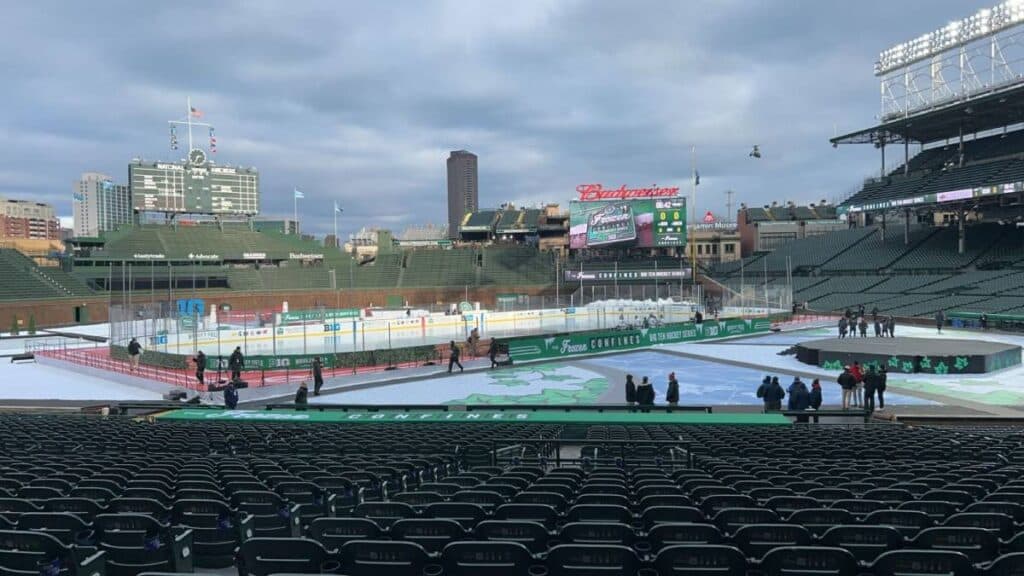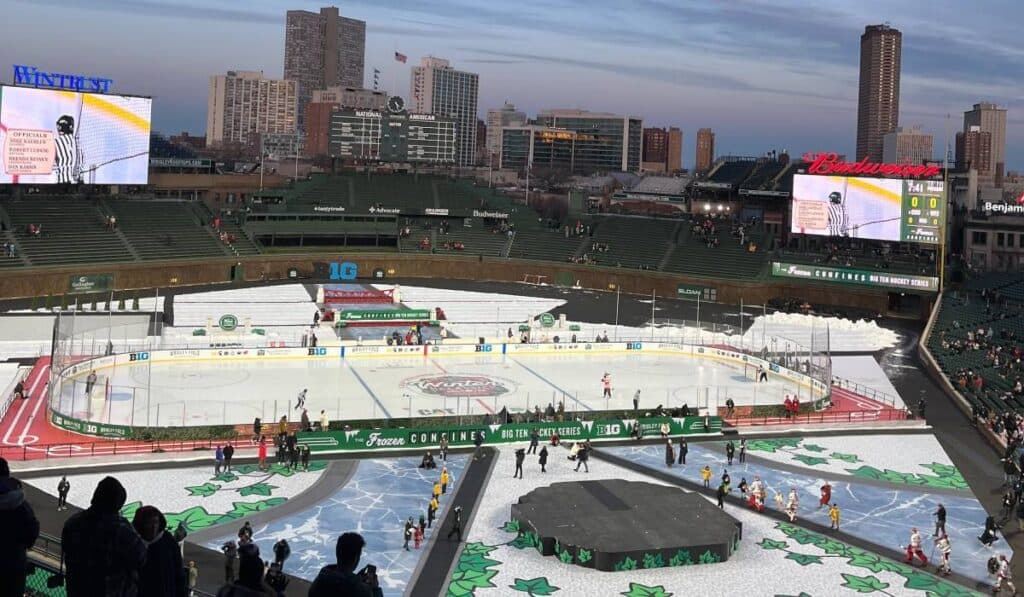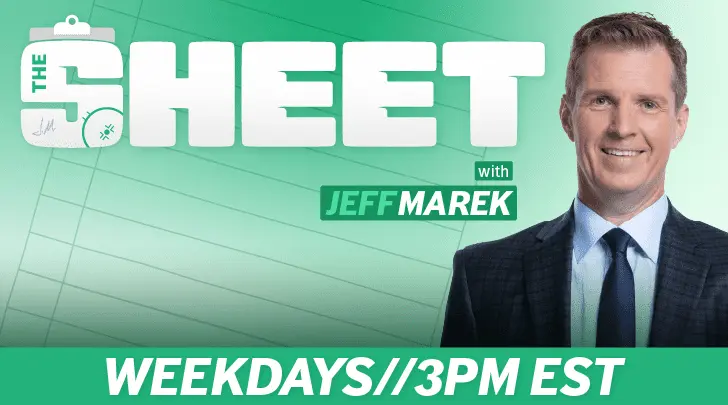Frozen Confines Big Ten Series proves Second City is hockey’s No. 1 host

CHICAGO – Sports are naturally hyperbolic. Tired cliches calling something the greatest this, the greatest that, a spectacular catch or tremendous save. We tend to overhype simple things to give them meaning or greater importance than they deserve. We’re talking about children’s games, for God’s sake.
But there are institutions that are deserving, hallowed grounds you could call cathedrals, and no one would bat an eye. There are very few places or things that really make you think, “This is something special,” but that’s the feeling you get when you walk into Wrigley Field, the 111-year home of Major League Baseball’s Chicago Cubs. The park is typically closed until mid-March, when preparations begin for the incoming six-month season (seven, if you’re lucky), but this year, the gates opened for the NHL and NCAA to host a series of hockey games played on an outdoor rink on the historic diamond.
First came the NHL, with the Chicago Blackhawks hosting the St. Louis Blues Dec. 31 for the league’s annual Winter Classic. More than 40,000 fans were in attendance, but they witnessed what many considered a dud, with the Blues taking it 6-2 and the game never really being competitive.
Days later, Wrigley Field hosted the Frozen Confines Big Ten Hockey Series, with American institutions like The Ohio State Buckeyes, Michigan Wolverines, Penn State Nittany Lions, Notre Dame Fighting Irish, Wisconsin Badgers and Michigan State Spartans competing in four games.

Taking the city’s Red Line subway on the way to the park, scores of adults both young and old wore their school’s colors, reciting memories of past outdoor games at other baseball and football fields. Some of the groups were alumni, holding mini-reunions in the Windy City, while some active student groups rented a bus and made the three-to-four-five hour long trek from Ann Arbor, or Madison, or Columbus, or South Bend.
The first of the four games was between the Buckeyes and Wolverines’ men’s teams on Friday afternoon. The attendance wasn’t anywhere close to the number that filled Wrigley Field on New Year’s Eve, but more than 25,000 were there for the first game, as Michigan fans mostly occupied the seats along the third base line, with Ohio State supporters along first base.
The ice wasn’t anything to write home about, with staff needing to shovel it every five minutes or so, stretching a typically two-and-a-half hour game into more than three, and the game being broken down to its simplest form: short, crisp passes, dump and chase, gets pucks to the net and bury the rebound. Officials weren’t afraid to put players in the box, with eight minor penalties being called between the second and third period, including a hooking call against Michigan’s Josh Eernisse with 68 seconds to go, leading to a Riley Thompson goal with 39 seconds left to seal a 4-3 win for the Buckeyes.
With each goal, fans erupted into their school’s fight song, which was expertly played by Wrigley Field organist John Benedeck. Each of the schools’ mascots took turns climbing on top of the dugouts, dancing to music and attempting to ignite the crowd. Every time a penalty was called – or missed – one side of the stadium rained the ice with boos that echoed through the Friendly Confines, while specks of the other side muttered phrases like, “good call stripes,” and “thank you!”
At puck drop of the first game, temperatures hovered at around 27 F, but by the time the second game began, it fell to 18 F, with fans able to see their breath with each exhale and their focus on staying warm instead of on the line matchups. When you walked through the team shops within the stadium, Wrigley Field-themed school shirts and toques were for sale, but what I expect was the bestsellers were the hand-warmers and Chicago Cub-themed blankets, strategically placed like impulse buys at the checkout. You could see the blankets scattered throughout the park, mostly shared by couples and families, only raising their hands from beneath the cloth to cheer after a goal.

One thing that stood out when speaking to players, as well as listening to anecdotes from previous outdoor games, is how little today’s generation of players actually spent outside. Most of today’s athletes train in weather-controlled environments, renting out indoor ice in the summer months and seldom carrying their sticks and skates to the local outdoor rink. There was a brief moment during the second game between Notre Dame and Penn State’s men’s teams, that fans were almost completely silent, and the sounds of pucks hitting sticks and skate blades carving the temporary ice could be heard from the top of the 100-year-old stadium. For many of the players, it may have been the first moment that they truly felt like they were on the pond.
When you’ve been to enough professional games, you tend to overhear the same conversations: so-and-so is overpaid, they need to fire what’s-his-name, and why haven’t they called up that guy? Narratives driven by contracts and salary caps and trade deadlines occupy the airwaves, and fans end up just repeating themselves. We as writers are guilty of it, as well, reinforcing these talking points and rehashing the same argument, over and over. But this past week, speaking with fans on the subway and in line for a Chicago dog, all of that was absent. The two days were invulnerable to cynicism, with amateur athletes competing for personal growth, collegiate pride, and fans of whatever two schools were playing in that moment taking part in good-natured ribbing, chanting their school’s fight songs and high-fiving with gloves on after every goal scored. It was a hockey environment unlike anything I had experienced before.
The week’s worth of hockey played at Wrigley Field and the tens of thousands who made the trip to Chicago proved that America’s Second City is first in the heart of hockey fans.
_____

The Sheet is live! Hosted by Jeff Marek, this brand-new show is your daily deep dive into the biggest hockey stories, trends, and insights across the NHL, PWHL, junior hockey, and beyond. Streaming every weekday at 3 PM ET on the Daily Faceoff YouTube channel, The Sheet features exclusive interviews with top hockey figures, from industry executives to Olympic champions. Don’t miss out—subscribe to Daily Faceoff on YouTube and follow @TheSheetHockey on social media to stay up-to-date with all the latest from the world of hockey.
_____